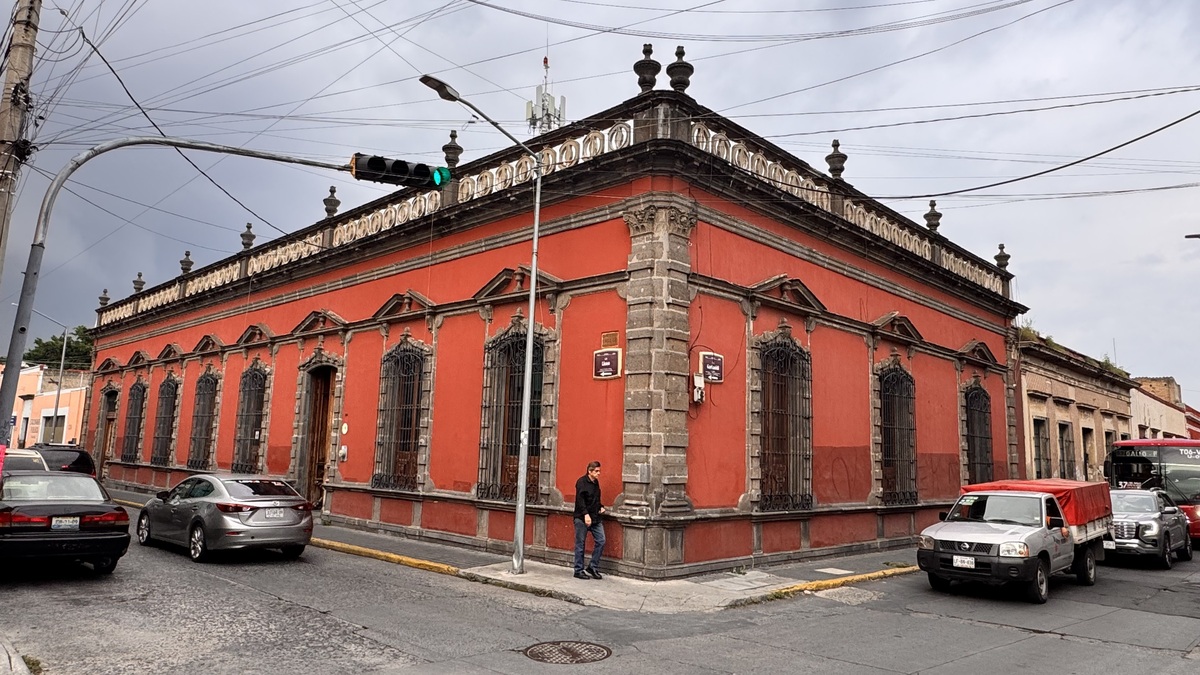





"Historic mansion for sale – Center of Guadalajara"
🏛 Casa Allende
Address: Calle Liceo 306 corner Garibaldi, Historic Center of Guadalajara
Sale price: $20,660,000 MXN
Land area: 738 m²
⸻
✨ Main features
• Neoclassical mansion with French influence from the 19th century.
• Monumental facade with gray quarry stone, Corinthian columns, and original balustrade.
• Five large windows and two accesses (pedestrian and carriage gate).
• Interior patio with retractable roof (sliding), ideal for events, natural lighting, and ventilation.
• Great potential for gardens or central terrace.
• Located on a strategic corner with double frontage.
⸻
🏛 History and heritage value
Built between 1880 and 1890 by Engineer Antonio Arroniz Topete for the landowner Sebastián Allende Rojas, owner of the Hacienda El Refugio (now Tequila Herradura).
Inhabited by his son, General Gregorio Sebastián Allende, governor of Jalisco (1932–1935) and a political figure of post-revolutionary Mexico.
⸻
🎯 Investment potential
Ideal for boutique hotel, cultural center, high-end restaurant, foundation, or premium corporate office.
⸻
📍 Prime location
• A few blocks from Guadalajara Cathedral, Rotonda de los Jaliscienses Ilustres, and Teatro Degollado.
• Area of high tourist traffic, historical and cultural.
———————————————————————————————
📰 HISTORICAL NOTE – GUADALAJARA
Guadalajara is a city with more than four centuries of history, whose architecture reflects the different influences that marked its development: from the Spanish foundation in the 16th century to the French influence of the Porfirio Diaz era and the modernization driven by English capital at the end of the 19th century.
🇪🇸 Spanish period (1542–1821)
• 1542: Definitive foundation of Guadalajara in the Valley of Atemajac.
• 1561–1618: Construction of Guadalajara Cathedral, the main religious and cultural emblem of the viceroyalty era.
• For almost three centuries it was the capital of New Galicia, consolidating as the political and economic center of the west.
• In 1821, with Independence, the colonial stage ended.
🇫🇷 French influence (1864–1910)
• After the French Intervention (1864–1867) and during the Porfirio Diaz era (1876–1911), the local elite adopted French-influenced styles in architecture, fashion, and customs.
• Mansions and buildings inspired by Europe were built:
• Teatro Degollado (1856–1866): neoclassical jewel.
• Expiatory Temple (1897): neo-Gothic emblem.
• Rotonda de los Jaliscienses Ilustres (1906).
• Many mansions from this era survive as a heritage legacy, including Casa Pedro Loza, Casa de los Perros, Casa Allende (1880s–1890s), Casa Razura (1910–1915), and Casa Francia 1333 (ca. 1910).
🇬🇧 English influence (1880–1910)
• The English mainly contributed in the economic and industrial fields.
• Investments in railroads, mining, and metallurgy marked the modernization of the region.
• Their footprint was more visible in infrastructure than in residential architecture.
🇲🇽 Mexican Revolution (1910–1920)
• It began in 1910 with the Plan of San Luis by Francisco I. Madero and ended the Porfirio Diaz era in 1911.
• The Constitution of 1917 marked the beginning of a new stage.
• Although the French influence lost strength, the mansions built between 1880 and 1910 remained as symbols of Guadalajara's cultural splendor.
📌 Together, these buildings and mansions form a unique historical corridor, where the transition from viceroyal Guadalajara to the cosmopolitan city of the late 19th and early 20th centuries can be appreciated.“Casona histórica en venta – Centro de Guadalajara”
🏛 Casa Allende
Dirección: Calle Liceo 306 esquina Garibaldi, Centro Histórico de Guadalajara
Precio de venta: $20,660,000 MXN
Superficie de terreno: 738 m²
⸻
✨ Características principales
• Casona neoclásica afrancesada del siglo XIX.
• Fachada monumental con cantera gris, columnas corintias y balaustrada original.
• Cinco ventanales y dos accesos (peatonal y portón de carruajes).
• Patio interior con techo retráctil (corredizo), ideal para eventos, iluminación natural y ventilación.
• Gran potencial para jardines o terraza central.
• Ubicada en esquina estratégica con doble frente.
⸻
🏛 Historia y valor patrimonial
Construida entre 1880 y 1890 por el Ing. Antonio Arroniz Topete para el hacendado Sebastián Allende Rojas, dueño de la Hacienda El Refugio (hoy Tequila Herradura).
Habitada por su hijo, el Gral. Gregorio Sebastián Allende, gobernador de Jalisco (1932–1935) y figura política del México posrevolucionario.
⸻
🎯 Potencial de inversión
Ideal para hotel boutique, centro cultural, restaurante de alto nivel, fundación o despacho corporativo premium.
⸻
📍 Ubicación privilegiada
• A pocas cuadras de Catedral de Guadalajara, Rotonda de los Jaliscienses Ilustres y Teatro Degollado.
• Zona de alta afluencia turística, histórica y cultural.
———————————————————————————————
📰 NOTA HISTÓRICA – GUADALAJARA
Guadalajara es una ciudad con más de cuatro siglos de historia, cuya arquitectura refleja las distintas influencias que marcaron su desarrollo: desde la fundación española en el siglo XVI hasta el afrancesamiento del Porfiriato y la modernización impulsada por capital inglés a fines del XIX.
🇪🇸 Periodo español (1542–1821)
• 1542: Fundación definitiva de Guadalajara en el Valle de Atemajac.
• 1561–1618: Construcción de la Catedral de Guadalajara, principal emblema religioso y cultural de la época virreinal.
• Durante casi tres siglos fue capital de la Nueva Galicia, consolidándose como centro político y económico del occidente.
• En 1821, con la Independencia, concluyó la etapa colonial.
🇫🇷 Influencia francesa (1864–1910)
• Tras la Intervención francesa (1864–1867) y durante el Porfiriato (1876–1911), la élite tapatía adoptó estilos afrancesados en arquitectura, moda y costumbres.
• Se levantaron casonas y edificios inspirados en Europa:
• Teatro Degollado (1856–1866): joya neoclásica.
• Templo Expiatorio (1897): emblema neogótico.
• Rotonda de los Jaliscienses Ilustres (1906).
• Muchas casonas de esta época sobreviven como legado patrimonial, entre ellas la Casa Pedro Loza, la Casa de los Perros, la Casa Allende (1880s–1890s), la Casa Razura (1910–1915) y la Casa Francia 1333 (ca. 1910).
🇬🇧 Influencia inglesa (1880–1910)
• Los ingleses aportaron principalmente en el ámbito económico e industrial.
• Inversiones en ferrocarriles, minería y metalurgia marcaron la modernización de la región.
• Su huella fue más visible en infraestructura que en arquitectura residencial.
🇲🇽 Revolución Mexicana (1910–1920)
• Inició en 1910 con el Plan de San Luis de Francisco I. Madero y puso fin al Porfiriato en 1911.
• La Constitución de 1917 marcó el inicio de una nueva etapa.
• Aunque el afrancesamiento perdió fuerza, las casonas construidas entre 1880 y 1910 quedaron como símbolos del esplendor cultural de Guadalajara.
📌 En conjunto, estos edificios y casonas forman un corredor histórico único, donde se aprecia la transición de la Guadalajara virreinal a la ciudad cosmopolita de finales del siglo XIX y principios del XX.

